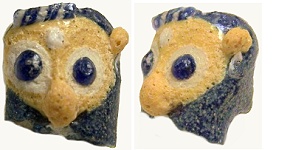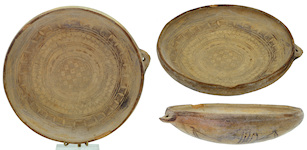Fine Coins Showcase
Antiquities Showcase
Hide empty categories
Shop Search
Shopping Cart
My FORVM
Contact Us
About Forum
Shopping at Forum
Our Guarantee
Payment Options
Shipping Options & Fees
Privacy & Security
Forum Staff
Selling Your Coins
Identifying Your Coin
FAQs
zoom.asp
Home ▸ Catalog ▸ |Antiquities| ▸ |Greek Antiquities||View Options:   | | | | | | |


From the collection of Alex G. Malloy, former dealer in antiquities for 40 years. Ex Jerome Eisenberg, 1970.AM35512. Marble head of Zeus; 4 ¼ x 4 inches; elegantly proportioned, Very attractive, large slightly almond shaped eyes looking ahead, straight nose (part is worn off), beard above and below the mouth; ears not present, some yellowing and brown, on black wood mount; of great rarity; SOLD
Cyprus, Red Polished Gourd Juglet, c. 2200 – 1750 B.C.


Red Polished Ware is a type of pottery from the Cypriot Bronze Age (2400 - 1600 B.C.), described as monochrome vessels with smooth surfaces, slipped in red or red-brown slips and burnished to a medium or high luster. Red Polished Ware includes a diverse range of vessel forms, including elaborate ritual vessels and zoomorphic shapes. Common decorations include incised motifs, relief decorations or mottled surfaces. Black rims and interiors to vessels were often created by use of specific and well-controlled firing techniques.AA43808. cf. CVA Online Austria IV p. 23, taf. 12, pl. 162, 2 (V 1089) (different patterns), Choice, small chip at rim repaired with tiny fragment missing, a few surface chips to body, wear to polish with small areas missing, c. 2200 – 1750 B.C.; buff clay, red slip burnished to luster, flared shallow funnel mouth, narrow tubular neck, handle from rim to shoulder with round cross section, piriform-spherical body with round bottom, neck and body decorated with white-filled incised geometric patters: horizontal bands, concentric circles, and herringbone, 13.8cm (5 3/8") tall, 9.0cm (3 1/2") diameter; SOLD
Ptolemaic or Roman Egyptian, c. 1st Century B.C.


From the collection of Alex G. Malloy, former dealer in antiquities for 40 years.
The mosaic glass making technique is a painstaking labor intensive process. Long colored glass rods (canes) are arranged and bundled to form the desired cross-section pattern. The rods are fused with heat and pulled to reduce the diameter and shrink the pattern to a smaller scale. The fused and pulled canes of glass are then cut into wafers, each piece bearing the original cross-section pattern in miniature. The wafers are then fused together to form the vessel. Millefiori, a combination of the Italian words "mille" (thousand) and "fiori" (flowers), is a distinctive and beautiful decorative pattern of mosaic glass.AM32450. millefiori fragment from a vessel of the finest quality, Superb, a true gem!, 5.7 cm (2 1/4"), dark brown background, white spiral striped rim, multiple millefiori designs of circles of green and white, red and yellow dots circles, red circles with small yellow dots; lovely and delicate; of great rarity; SOLD
Punic (Carthage or Syria Palaestina Coast), Glass Caricature Head Pendant, Late 6th - 5th Century B.C.


From the collection of Alex G. Malloy, former dealer in antiquities for 40 years.
A recent European auction listed a similar but complete piece with an estimate of 18,000 Euros! SH32405. Head pendant; cf. Corning Pre-Roman 214, Choice, 1.6 cm (5/8"), core-formed, yellow face and ears, white eyes with blue centers, white blob center of forehead, blue beard, blue and white spiral striped hair band, lower beard, back and loop missing; rare; SOLD
Babylonia, Seleukid - Parthian, Terracotta Plaque of Kissing Couple, c. 300 B.C. - 200 A.D.


AT31039. cf. Hopper Figurines Fig. 5 (Nippur) & Fig 6 (Babylon); height 11 cm (3 7/8"), Choice, one-sided, SOLD
Cypriot Bichrome Ware Plate, Geometric Period. c. 1050 - 750 B.C.


W. & J. Sloane was a luxury furniture and rug store in New York City that catered to the prominent, including the White House and the Breakers, and wealthy, including the Rockefeller, Whitney, and Vanderbilt families. After a long period of prosperity and prominence, the firm went through a short period of decline and was forced to file for bankruptcy in 1985.
The plate or dish was a late arrival to Cyprus and Philistia absent from indigenous Bronze Age pottery. It arrived as a Greek import, and was adopted locally in the Early Iron Age, Geometric Period, c. 11th century B.C.AA23948. Cypriot bichrome ware plate, Choice, complete and intact, some paint loss, minor chips in rim, c. 1050 - 750 B.C.; wheel made beige pottery, shallow hemispherical bowl, inverted rim, single small pierced horizontal handle, flattened bottom, painted black and umber geometric patterns inside and out, fine checkerboard, web and wave patterns in concentric circles on inside; ex W & J Sloane with torn price sticker on bottom; SOLD
Greek, Tegea, Archaic Terracotta Bust of Kore, 6th Century B.C.


From the collection of Alex G. Malloy, former dealer in antiquities for 40 years. AT34451. Bust of Kore, 8 cm (3") high, cream terracotta; Kore wearing polos, hair braided down sides, necklace with amulets attached, archaic eyes, Choice - Superb, beautiful style, unmounted; SOLD
Holyland, Hellenistic Greek, Pottery Oil Pouring Vessel, 3rd Century B.C.


Many ancient cites the Holyland were centers of Hellenic culture, beginning from early in the Hellenic Period, and remaining so under Hasmonean, Herodian, and Roman rule. Some of these Hellenic cities, those that became the Decapolis under Rome, included Scythopolis (modern Bet She'an, Israel), Hippos, Gadara, Raphana, Dion (or Dium), Pella, Gerasa, Philadelphia (modern Amman, Jordan), Canatha, and Damascus (capital of modern Syria).AA99535. Hellenistic Greek, pottery oil pouring vessel, Choice, complete and intact, some paint lose, some tiny chips; 9.6cm (3 3/4") tall to top of handle, 8.3mm (3 1/4") wide to tip of spout; pink-cream clay (Munsell color 7.5 YR 8/3), 3rd Century B.C.; reverse wheel made, pale-brown clay, teardrop body with a flat top and bottom tapered to a wide foot, spout at shoulder, strap handle looping high from the mouth to the shoulder, the top half of the vessel including the spout and handle is painted black; Archaeological Center (Robert Deutsch, Tel Aviv, Israel) auction 53 (4 Oct 2012), lot 122; found in Israel; SOLD
Greco-Roman Anatatolia (Smyrna, Ionia?), Terracotta Woman Holding Infant, 2nd century B.C. - 1st century A.D.


Kourotrophos (Greek: "child nurturer") was an Athenian deity, the protector of children and young people, with a cult and sanctuary, the so-called Kourotropheion. Gods and goddesses, including Athena, Apollo, Hermes, Hecate, Aphrodite, and Artemis, are given the epithet Kourotrophos when depicted holding an infant. Figurines of females holding infants are also called Kourotrophos. The purpose of kourotrophic figurines is debated. Perhaps they are representations of the Athenian goddess. Perhaps they were fertility or childbirth charms. They are found in graves, so perhaps they were companions for the dead.
We were unable to find another example of this type. Attribution to Smyrna, Ionia is based on the color and texture of the clay, and on the style and workmanship.AH21487. Terracotta kourotrophos statuette of a woman holding a swaddled infant, 25cm (9 7/8") tall, mold-made, hollow and without back, Choice, complete and intact, old dealer labels on the reverse, stands on its own base, Late Hellenistic to Roman Era; SOLD
Hellenistic Greek, Bronze Relief Ring Fragment, Eastern Mediterranean, 3rd - 1st Century B.C.


AS97046. cf. BM Collection 1917.0501.1267 (very similar ring fragment), obverse high relief portrait of a woman facing left, draped and wearing her hair in a bun at the back (perhaps a Ptolemaic queen, either Berenike II or Arsinoe II); SOLD

You are viewing a SOLD items page.
Click here to return to the page with AVAILABLE items.
The sale price for a sold item is the private information of the buyer and will not be provided.



REFERENCES
Page created in 1.187 seconds.







